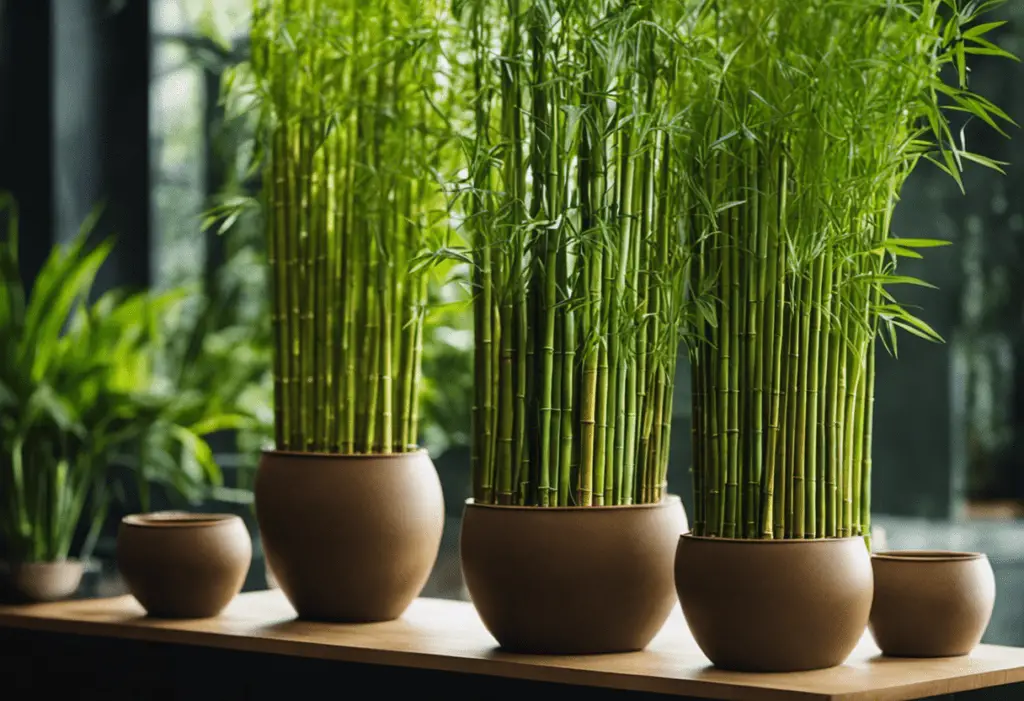Whether you have limited outdoor space or simply prefer the convenience of container gardening, this guide will cover everything from selecting the appropriate bamboo species to optimal container placement and care.
Key Takeaways
- Consider the growth habit and adaptability of the bamboo species to container gardening.
- Opt for smaller bamboo species with a clumping growth habit and a shorter growing season for container cultivation.
- Select containers with good drainage and enough space for the bamboo’s root system.
- Place the container bamboo in a location with sufficient sunlight and wind protection, and regularly inspect for pests and diseases.
Bamboo Types For Pots

When selecting bamboo types for pots, it is important to consider their growth habits, ornamental features, and adaptability to container gardening. Bamboo is a versatile plant that can thrive in various environments, but not all types are suitable for growing in pots or containers.
One important factor to consider is the growth habit of the bamboo. Some varieties, like the running bamboo, have aggressive spreading roots that make them unsuitable for container gardening. On the other hand, clumping bamboo types are better suited for pots as they have a more compact growth habit and do not spread rapidly.
Another consideration is the ornamental features of the bamboo. Some bamboo varieties have stunning foliage colors, such as the black bamboo with its dark purple stems, or the golden bamboo with its vibrant yellow culms. These ornamental features can add visual interest to your container garden.
Lastly, the adaptability of the bamboo to container gardening is crucial. Certain bamboo types are more tolerant of being confined to a pot and can thrive in limited root space. These varieties are well-suited for growing in containers and can be enjoyed on balconies, patios, or small gardens.
When choosing bamboo types for pots, it is important to keep these factors in mind to ensure a successful and visually appealing container garden.
Best Bamboo To Grow In Pots
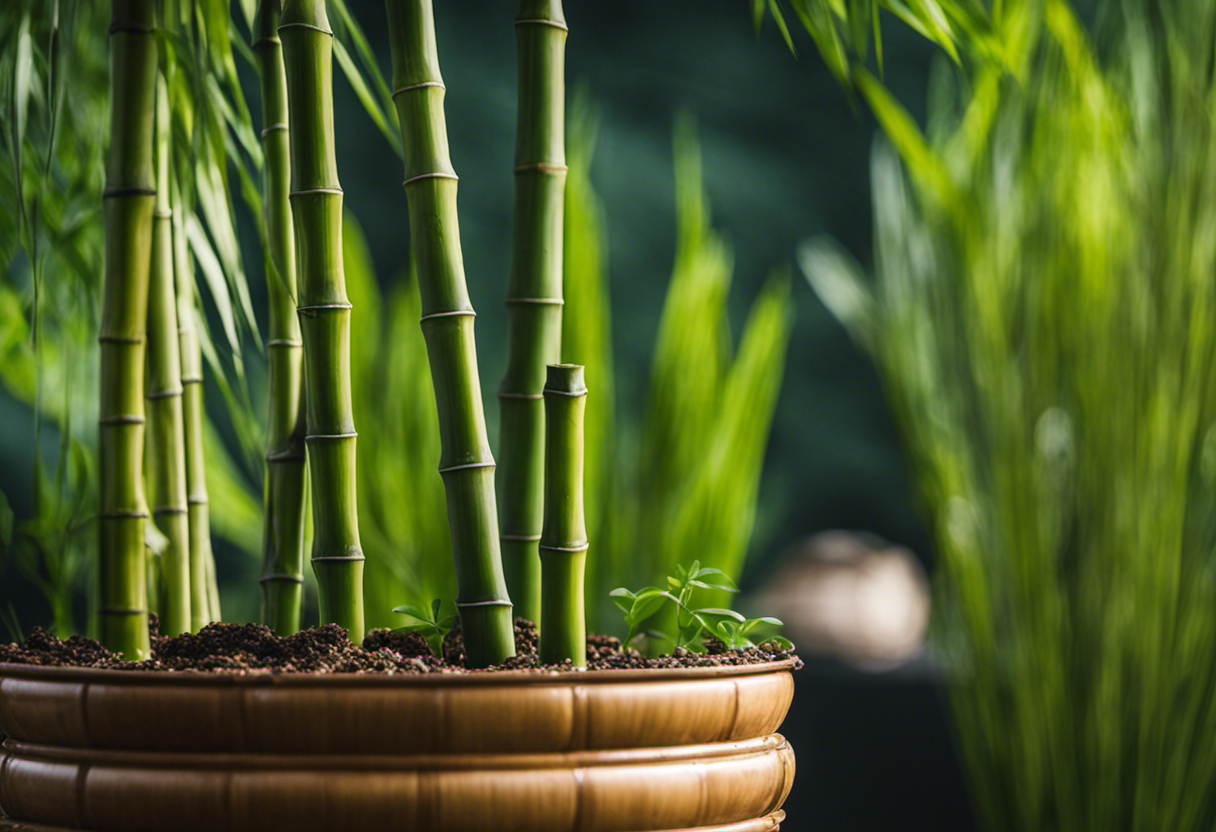


To achieve optimal results, it is essential to carefully select the best bamboo species for growth in pots and containers. When choosing bamboo for planting in pots, consider the following three factors:
-
Size: Opt for bamboo species that are smaller in size and have a clumping growth habit. Dwarf bamboo varieties such as Bambusa multiplex or Fargesia spp. are ideal choices for container gardening. These species tend to grow to a manageable height of 6 to 10 feet, making them suitable for indoor or patio cultivation.
-
Growth Season: Some bamboo species have a shorter growing season, making them more suitable for container cultivation. Clumping bamboos like Bambusa multiplex or Fargesia spp. have a shorter growth season compared to running bamboos. This characteristic allows them to thrive and develop healthy root systems in limited spaces.
-
Container and Drainage: Choose a container that is large enough to accommodate the bamboo’s root system and has good drainage. Bamboo roots can quickly outgrow their containers, so it’s crucial to provide ample space. Additionally, ensure the container has drainage holes to prevent waterlogging, which can cause root rot. Using a well-draining potting mix is also essential for the healthy growth of bamboo in containers.
Where To Place Container Bamboo



Ideally, container bamboo should be placed in a location that receives ample sunlight and provides protection from strong winds. Sunlight is crucial for the growth and health of bamboo plants, as it aids in photosynthesis and promotes vigorous growth. Therefore, it is recommended to place your container bamboo in an area that receives at least six hours of direct sunlight each day.
In terms of wind protection, bamboo plants are susceptible to damage from strong winds, especially when grown in containers. Strong gusts can easily topple the plant or damage the delicate foliage. To protect your bamboo, consider placing it in a location that is sheltered from strong winds, such as near a wall or fence.
Additionally, it is important to choose the right planter for your bamboo. The container should have good drainage to prevent waterlogging, which can be detrimental to the plant’s roots. Repotting may be necessary as the plant grows, so choose a planter that allows for easy transplanting.
To further enhance the growth of your container bamboo, consider mulching around the base of the plant. Mulch helps retain moisture, regulates soil temperature, and suppresses weed growth. Organic mulch, such as wood chips or straw, is recommended for bamboo plants.
Lastly, regularly inspect your bamboo for any signs of pests or diseases. Common pests that may affect bamboo include aphids, mealybugs, and spider mites. Promptly address any issues by implementing appropriate pest control measures to ensure the health and vitality of your container bamboo’s foliage.
When To Plant Bamboo In Pots



Frequently, gardeners wonder about the optimal timing for planting bamboo in pots to ensure successful growth and establishment. The timing of planting bamboo in pots is crucial as it directly impacts the plant’s ability to adapt and thrive in its new environment.
Here are three key factors to consider when determining the best time to plant bamboo in pots:
-
Climate: Bamboo is a versatile plant that can grow in a wide range of climates, but it’s important to choose the right species that is suitable for your specific climate. Research the recommended planting time for the bamboo species you’ve chosen, as some varieties prefer cooler temperatures while others thrive in warmer climates.
-
Growing Season: It’s generally recommended to plant bamboo in pots during the growing season. This allows the plant to establish its root system and take advantage of the favorable conditions for growth. In most regions, the ideal time for planting bamboo is in spring or early summer when the soil has warmed up and there is no longer a risk of frost.
-
Soil Conditions: Before planting bamboo in pots, ensure that the soil is well-draining, rich in organic matter, and has a slightly acidic to neutral pH. Avoid planting during periods of heavy rainfall or when the soil is waterlogged, as this can lead to root rot and other issues.
Choosing Containers



The selection of suitable containers is a crucial aspect when growing bamboo in pots and containers. Choosing the right container can greatly contribute to the success of your bamboo growing endeavors. It is important to consider the size, material, and drainage capabilities of the pot or container.
Size: Bamboo plants have extensive root systems, so it is important to choose a pot that is large enough to accommodate their growth. As a general rule, the container should be at least 2-3 times the size of the plant’s root ball.
Material: When it comes to choosing the material for your pot or container, there are several options to consider. Terracotta pots are a popular choice as they provide good drainage and allow for air circulation. Plastic containers are lightweight and easy to move around, but they may not be as aesthetically pleasing as terracotta. Fiberglass and metal containers are also options to consider, but they may require additional insulation in colder climates.
Drainage: Proper drainage is essential for the health of your bamboo plant. Make sure the pot or container has drainage holes to prevent waterlogging, which can lead to root rot. Elevating the pot on feet or bricks can also improve drainage.
To further help you make an informed decision, the table below provides a comparison of different container materials:
| Material | Pros | Cons |
|---|---|---|
| Terracotta | Good drainage, air circulation | Can be heavy, may crack |
| Plastic | Lightweight, easy to move | May not be as visually pleasing |
| Fiberglass | Durable, lightweight | May require additional insulation |
| Metal | Sturdy, long-lasting | Can get hot in direct sunlight |
Filling Containers
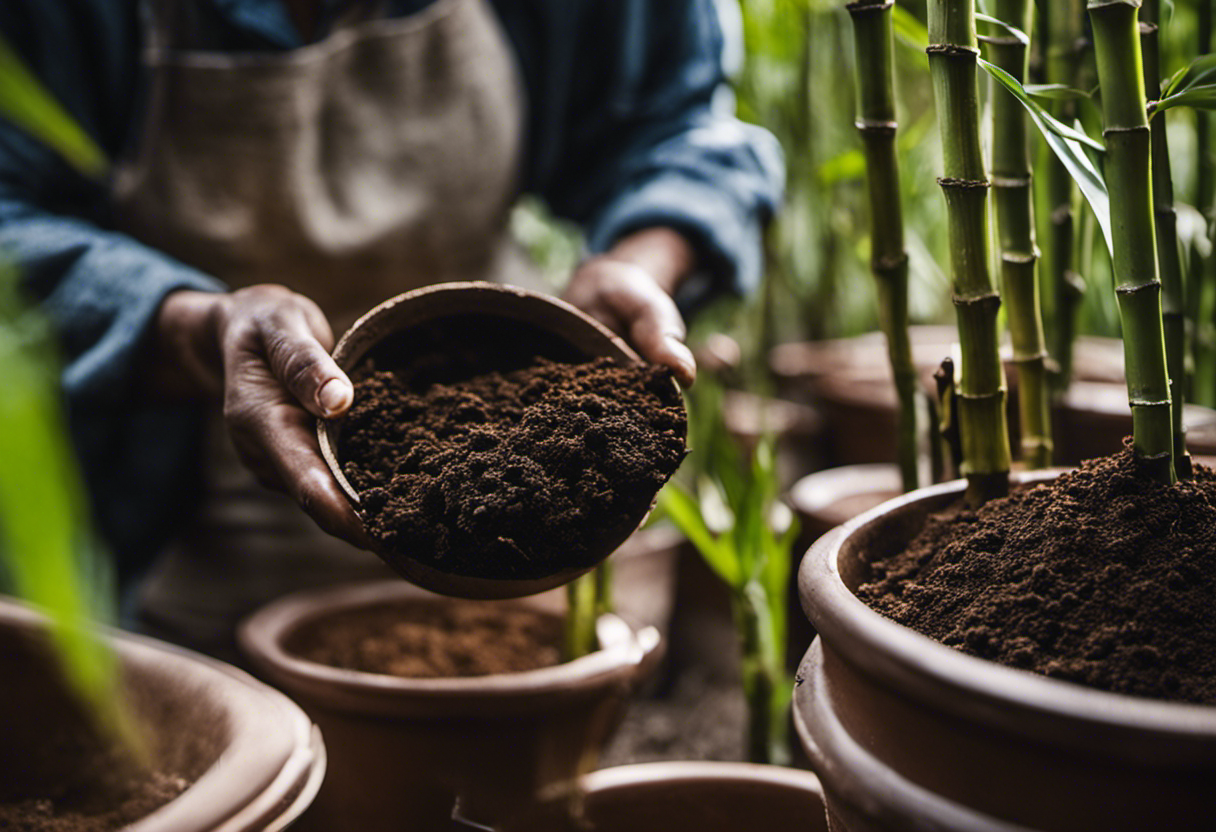


Bamboo plants require a well-balanced and nutrient-rich soil mix, so it is important to carefully select and combine the appropriate components when filling containers. Here are three key items to consider when filling containers for bamboo plants:
-
Soil Mix: Use a good quality potting soil that provides both drainage and moisture retention. Avoid using heavy clay soils, as they can become compacted and hinder root growth. The ideal soil mix for bamboo should be loose and friable, allowing for proper aeration and water movement.
-
Organic Matter: Adding organic matter to the soil mix is crucial for the success of bamboo plants. Incorporate well-rotted compost, leaf mold, or aged manure to improve the soil’s fertility and structure. This will provide essential nutrients and promote healthy root development.
-
Mulch Layer: Apply a layer of organic mulch on top of the soil to conserve moisture, suppress weed growth, and regulate soil temperature. Use materials such as wood chips, straw, or shredded leaves. Mulching will help maintain an even moisture level and protect the bamboo’s shallow root system.
Planting Bamboo
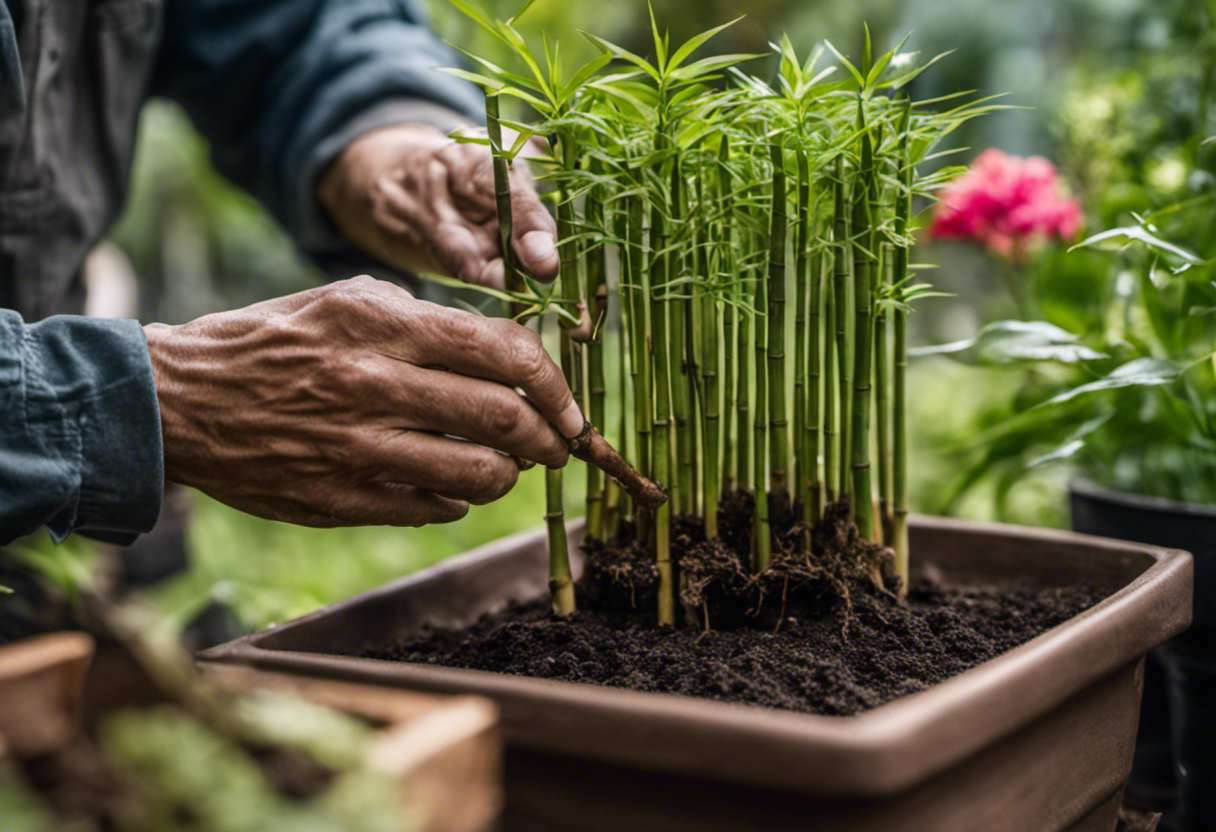


To ensure successful establishment, carefully position and set the bamboo plant into the prepared container, taking into account its growth habit and desired placement within your garden or landscape. Start by selecting a container that is large enough to accommodate the bamboo’s root system and allows for future growth. Make sure the container has drainage holes to prevent waterlogging, as bamboo prefers well-drained soil.
When planting the bamboo, gently remove it from its nursery pot, being careful not to damage the roots. Place the bamboo root ball into the container, ensuring that it is centered and at the same level as it was in the nursery pot. Fill the container with a well-draining potting mix, pressing it firmly around the roots to eliminate air pockets.
After planting, water the bamboo thoroughly to settle the soil and promote root establishment. Water regularly, keeping the soil moist but not waterlogged. Fertilize the bamboo regularly with a balanced fertilizer to provide essential nutrients for healthy growth. Prune any dead or damaged canes to maintain the bamboo’s appearance and promote new growth.
Potted Bamboo Care
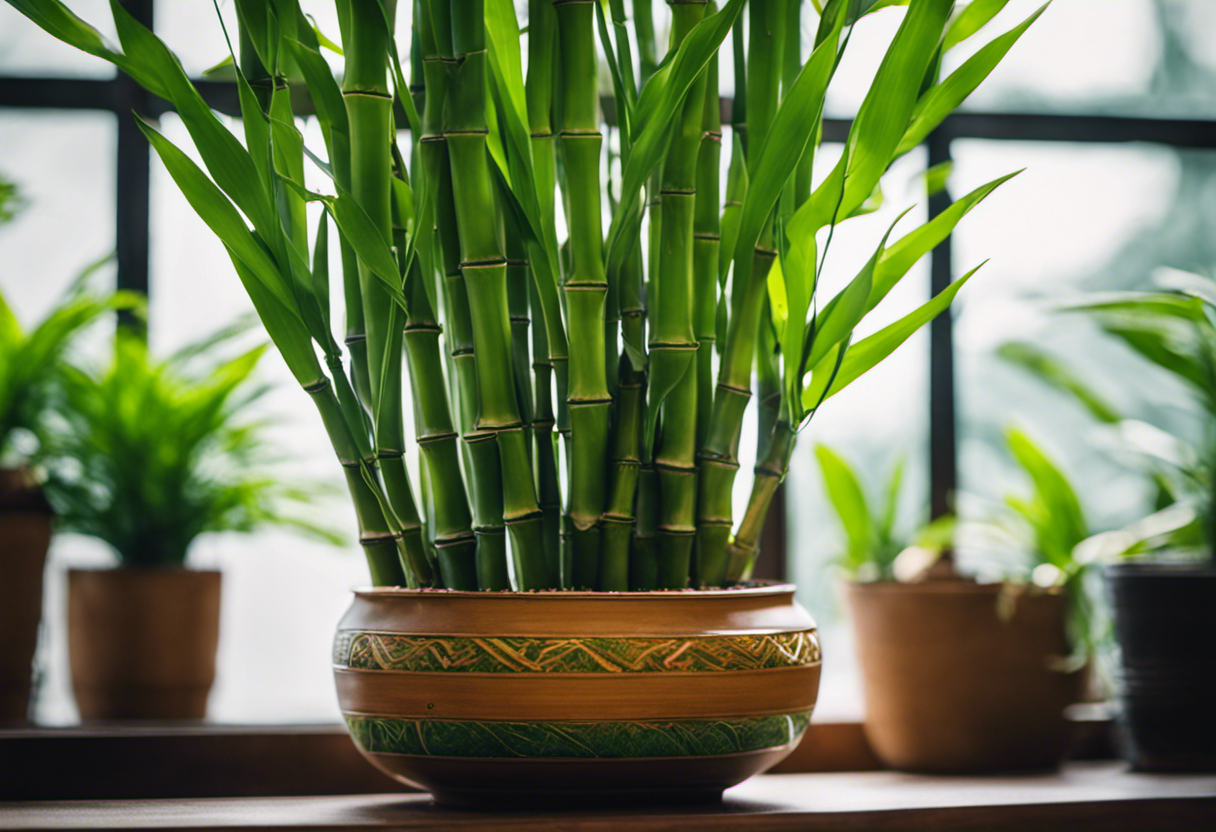


Proper maintenance and attention are essential for the successful growth and longevity of potted bamboo. Taking care of your potted bamboo involves a combination of providing the right conditions and regularly monitoring its health. Here are three important factors to consider when caring for your potted bamboo:
-
Watering: Bamboo plants require consistent moisture, so it is crucial to water them regularly. Check the soil moisture level by inserting your finger into the potting mix. If it feels dry, it’s time to water. Avoid overwatering, as it can lead to root rot. Ensure proper drainage by using well-draining soil and pots with drainage holes.
-
Fertilization: Potted bamboo plants benefit from regular fertilization to replenish nutrients. Apply a balanced, slow-release fertilizer during the growing season, following the product’s instructions. Avoid using excessive amounts of fertilizer, as it can cause burning of the roots.
-
Sunlight and Temperature: Most bamboo species thrive in full sun or partial shade. Ensure your potted bamboo receives at least 6 hours of direct sunlight daily. Protect the plant from extreme temperature fluctuations, as bamboo prefers stable conditions. In colder climates, consider moving the potted bamboo indoors during the winter months to protect it from freezing temperatures.
Conclusion
In conclusion, growing bamboo in pots and containers can be a rewarding experience.
By choosing the right bamboo type, selecting suitable containers, and providing proper care, it is possible to successfully cultivate bamboo in a limited space.
With attention to detail and following the recommended guidelines for planting and caring for potted bamboo, enthusiasts can enjoy the beauty and benefits of this versatile plant in their homes or gardens.

